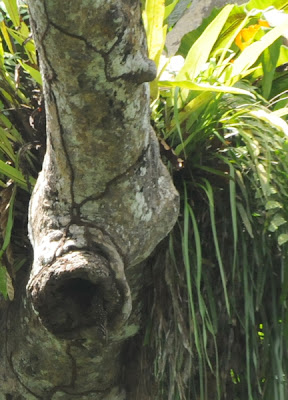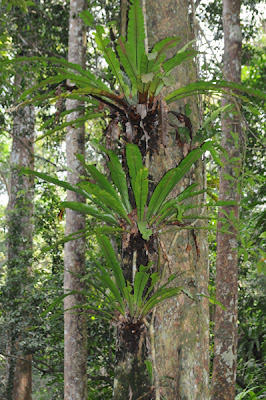Wilbur had arranged our permits (a necessity for Panti visitors), allowing us to explore both the well-known Bunker Trail, its entrance marked by two enormous concrete bunkers, and a dirt road to the south that proved even better (and gave me good looks, but no photos, of Panti's number one target bird, the Rail-Babbler (Eupetes macrocerus).
Hunting for Rail-babblers involves plunging into the forest itself, giving me an excellent chance to encounter some of the less attractive members of the local fauna.
Thanks to Panti's leech population, I can literally say that I paid for my Rail-Babblers in blood! This one, straining out for someone to latch on to, is probably Haemadipsa zeylanica.
Though this was definitely a birding trip (as evidenced by such excellent birders as Jasmine and John Steed and Mark Ng), this post is not about birds (that'll come next time). Instead, we'll look at some of the other things Panti has to offer.
That can include the plants of which the forest is built: trees, and their loads of epiphytes like these Bird's-nest Ferns (Asplenium sp.)

I have no idea what plant bears these magnificent globular clusters of flowers, but there seemed to be quite a lot of them at Panti.
The combination of bright pink stems and dark bluish-black berries on this plant remind me of members of the pokeberry family (Phytolaccaceae), but I have no idea if this actually is one.

And what plant produces these flaming red roots?
This fungus was being visited by numbers of tiny bees, just visible in the photograph - a good way to segue across three biological kingdoms, from plants to fungi to animals.
Sticking with insects, here is a rather fearsome ant...
Some impressive millipedes crossed our path: this is a Tractor Millipede (Barydesmus sp).
We found this giant millipede, perhaps a member of the genus Ommatoiulus, on the last day of our visit to Panti.

In the meantime, here are some large water striders (Gerridae).
The large black blotch below the dorsal fin on these little fishes identifies them as Saddle Barbs (Systomus banksi), a social species of clear forest streams. Apparently they were once kept in village wells as a sign that the water was safe to drink.

Night provides an opportunity to find a few more frogs...

In one roadside pond I found this foam nest suspended just above the water surface.
+poss.JPG)
A Green Crested Lizard (Bronchocela cristatella) eyed me from a low bush along the Bunker Trail...
While this unidentified skink checked me out from atop a small stump.

Mammals along the trails included the common Plantain Squirrel (Callosciurus notatus).
The Slender Squirrel (Sundasciurus tenuis) is smaller than the Plantain Squirrel, and is more strictly an inhabitant of forests.
This Southern Pig-tailed Macaque (Macaca nemestrina) peered at me from behind the safety of a tree.
The macaque was investigating the edges of a (surely illegal) campsite in the forest off the southern trail, presumably the work of local hunters or poachers. There were game guards nearby (who harassed us about the validity of our permits), but the camp appeared to be unmolested.
It's worrisome that they were there, because Panti is also home to some of the few remaining Malaysian Tigers (Panthera tigris), one of which probably left this pug mark in the mud of the Bunker Trail. The splendour of Malaysia's wildlife is, alas, often matched by its precariousness.
















.JPG)
.JPG)
.JPG)
.JPG)
.JPG)
.JPG)
.JPG)





+poss.JPG)
+poss.JPG)
.JPG)
.JPG)

.jpg)
.JPG)
.JPG)


No comments:
Post a Comment